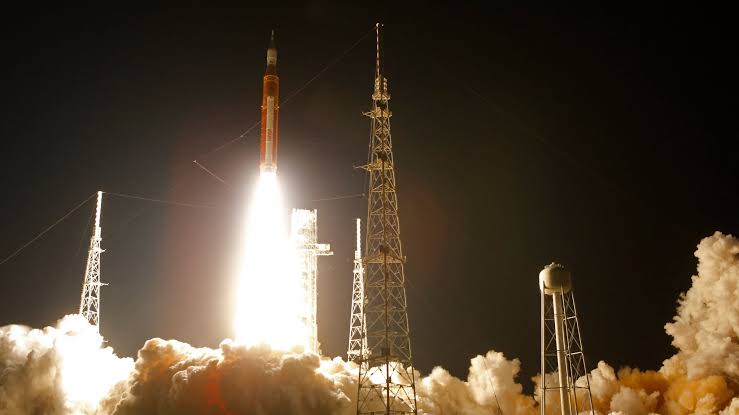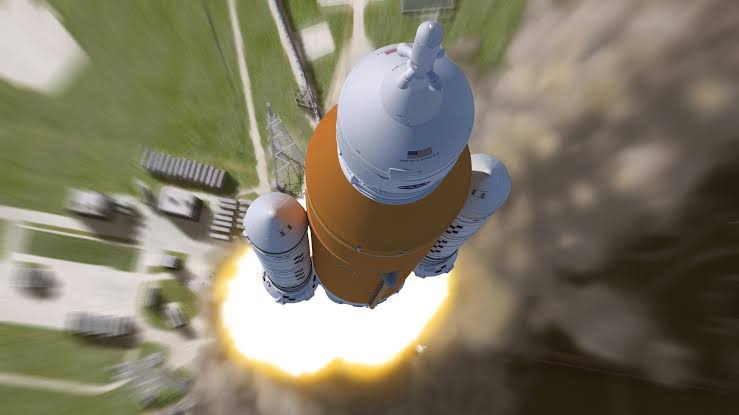Updates Of NASA’s Artemis I Mission
After numerous failed attempts and months of delays, NASA finally launched the Artemis I mission to the Moon. The Orion spacecraft on top of the Space Launch System was launched by the American space agency in a two-hour window on a voyage that will take it past the Moon and back.
Date: 16 November 2022,
Time: 12:18 IST
Related: Liftoff! NASA’s Artemis I Mega Rocket Launches Orion to Moon
NASA sends Artemos I into lunar orbit

The Artemis I mission to the Moon has been launched by NASA. The spacecraft blasted off from Cape Canaveral’s Kennedy Space Center for a trip to the Moon and back.
Time: 12:07 IST
Everything is set for launch.
The launch manager has given the go-ahead for Artemis I. The Space Launch System’s upper and lower stages have finished construction, and the flight director is currently conducting a survey. According to flight engineers, there are no restrictions for launch, and the team is preparing for launch readiness.
Time: 11:34 IST
The countdown pause is being extended: NASA
Update from NASA: While the launch crew determines how much work needs to be done, we are prolonging the countdown hold at T-10 minutes. This indicates that we will miss the two-hour launch window; we will announce a new launch time as soon as it is set.
Time: 11:33 IST
There is no updated launch window yet: NASA
Derrol Nail of NASA stated that the Space Launch System is still under construction and that no new launch time is yet available. It is now possible to launch within the next two hours; it will end at 1:30 IST.
Time: 11:28 IST
NASA extends the hold forever.
The launch has been postponed indefinitely by NASA. The last of the four Space Launch System tanks to be fully fueled before launch is the upper stage, which is 95% full. According to NASA, “We are awaiting some range work and making sure that the airspace and ocean flight path is free.”
Time: 11:25 IST
The launch crew chooses a new launch time: Nasa
Latest NASA news | Liquid hydrogen in the upper stages is currently “topping.” The Flight Termination System is being tested by the Range Safety Officer (FTS). Our new launch time is being chosen by the launch team.
Time: 11:23 IST
What is the first biological test that Artemis I is sending to the moon?
Although there won’t be any people on board when the Artemis I mission launches to the Moon, a special group of CubeSats will be there to lay the framework for the crew who will arrive a few years later. The first biological experiment going into lunar orbit is one of the payloads.
Time: 11:16 IST
A Space Expedition
The Orion spacecraft will take off on the most potent rocket in history and travel farther than any human-built spacecraft has ever done.
Over the course of a four to six-week mission, it will travel 4.5 lakh kilometres from Earth and thousands of kilometres beyond the Moon.
Orion will return home faster and hotter than ever before after spending more time in space than any other ship for astronauts has without docking to a space station.
Time: 11:13 IST
What is the goal of Artemis I?
In order to establish a permanent human presence on the Moon, Artemis I will be the first in a line of missions that get progressively more difficult. Prior to the first flight with crew on Artemis II, Artemis I’s main objectives are to demonstrate Orion’s systems in a spaceflight environment and to guarantee a safe re-entry, descent, splashdown, and recovery.
This unmanned flight test will lay the groundwork for human deep space exploration and show our willingness and capacity to take human civilization to the Moon and beyond.
Time: 11:00 IST
Launch of Artemis I is postponed
The launch was put on hold when the countdown clock was stopped by engineers. The wait will last for around 30 minutes while engineers address Ethernet faults and fill the tanks.
Time: 10:34 IST
What happened during NASA’s previous attempt to launch Artemis I to the Moon?
The American space agency has made previous attempts to launch the mission without success. There have previously been two such attempts that Nasa had to give up on due to leaks and engine problems.
NASA is once again counting down the minutes until the first flight test of its brand-new, 32-story-tall Artemis rocket, which the organization believes may one day return men to the moon.
The space agency has been striving to launch the multi-billion dollar rocket so that it can fly a capsule around the moon and back without a crew, enabling management to conduct crucial system testing.
Lift-off is now planned for a two-hour window that begins at 1:04 am EST on Nov. 16 and the Florida launch location is expected to have good weather. You can watch the launch live online here
At the Kennedy Space Center for NASA, Jeremy Parsons, deputy programme manager for exploration ground systems, told reporters on Monday night that “the countdown so far is running extremely well and we are on schedule.”
Related: Artemis 1: NASA’s Mega-Rocket Rolled Back To The Launchpad For Its First Lunar Flight
Significance Of NASA’s Artemis I

For NASA’s Artemis I mission, which seeks to land the first woman and the first person of color on the lunar surface, a successful launch would be a significant accomplishment. Since 1972, the organization has not launched an astronaut-transporting spacecraft.
The Artemis rocket’s inaugural launch attempt was aborted in August due to a malfunctioning engine sensor. After that, the agency had to perform repairs due to hydrogen fuel leakage. The rocket was then forced to return to its hangar as Hurricane Ian moved in, which Parsons described as “a bit of a let-down.”
Delay Due To Hurricane
Additionally, Hurricane Nicole, which turned out to be a larger storm than officials had anticipated, pounded the enormous rocket as it arrived back at its launch pad on the Florida coast.
The Orion crew capsule is located up where a thin strip of caulking material fills in a small gap at the top of the rocket. Mission managers have spent a lot of time discussing hurricane damage to this area. This cloth has some rips in it, but they are too high up to be mended.
One worry was that more pieces might get loose during takeoff and collide with other components of the rocket. However, NASA’s Mike Sarafin, the Artemis I mission manager, claims that engineers have thoroughly examined the scenario and believe it is safe to fly.
In a conference call on Monday, Sarafin told reporters, “We went over that today and we closed that action item. We agreed to the flight explanation after I asked if there were any conflicting opinions.
He states, “That gives me comfort that we’re going to be ready when it’s our time to fly,” because the Artemis team has persisted despite all of these recent disappointments.
“Our moment is now. And we anticipate that it will occur on Wednesday, “said Sarafin. The next obstacle, the next test, will be faced and overcome if Wednesday is not the right day.
Cost Of The Flight
The first three flights are anticipated to cost more than $4 billion each, and some spaceflight experts have criticized NASA’s new rocket as being far too expensive to be financially feasible.
Additionally, this rocket won’t launch very often. In a few more years, the next mission, which will bring astronauts around the moon, will take place. At the earliest, a lunar landing won’t take place until 2025.
However, since the space shuttle programme was discontinued in 2011, NASA’s human spaceflight programme has been heavily focused on creating this large rocket.
Conclusion
The agency delegated routine visits to the International Space Station to private companies in order to concentrate on the moon and deep space.
Elon Musk, a successful businessman, launched the private corporation SpaceX, which has been using its spacecraft to transport people and freight into space.
NASA chose SpaceX to construct the lunar lander that will carry astronauts from an orbiting spacecraft to the moon’s surface.
Additionally, SpaceX is working on a big rocket named Starship that will be cheaper and more durable than NASA’s Artemis rocket.
